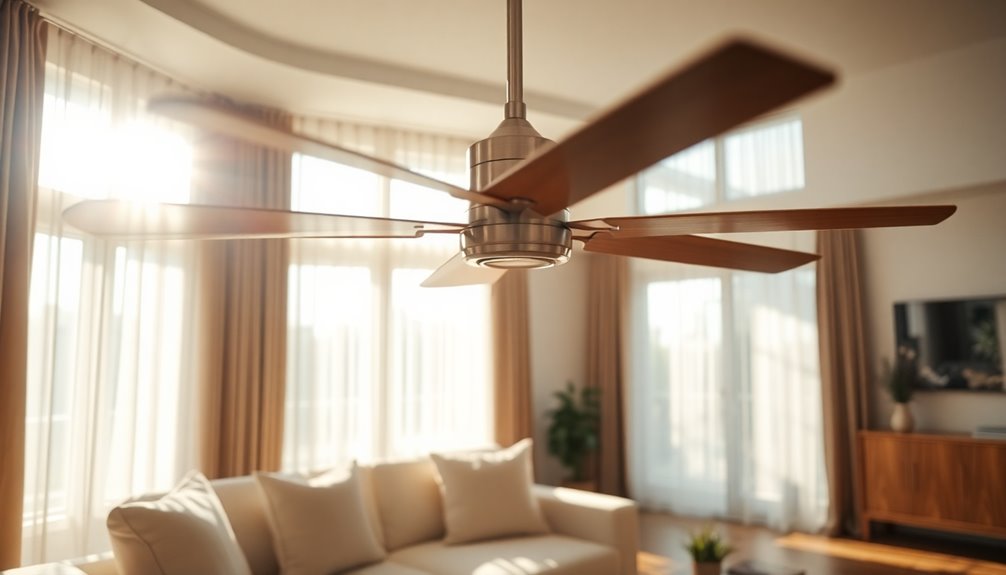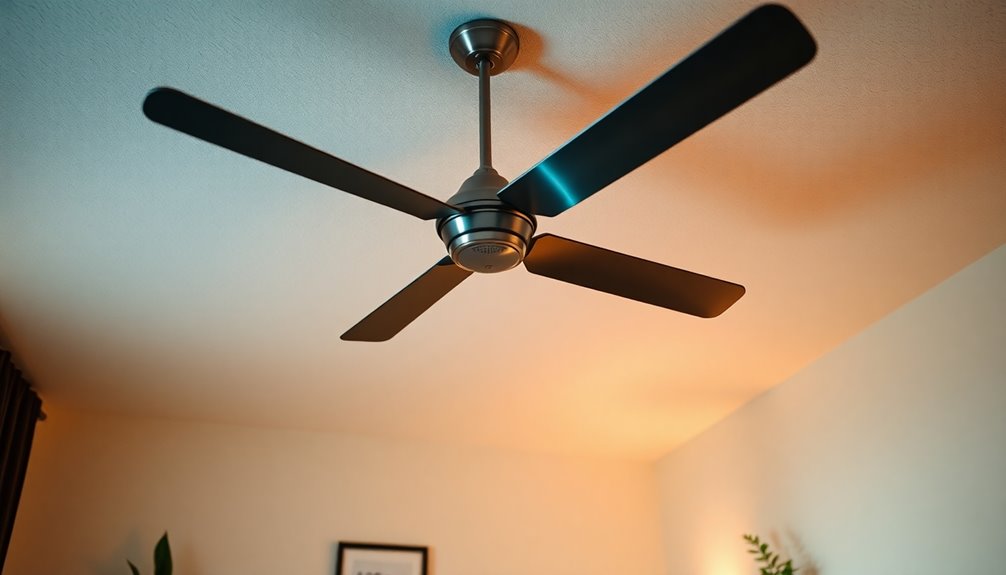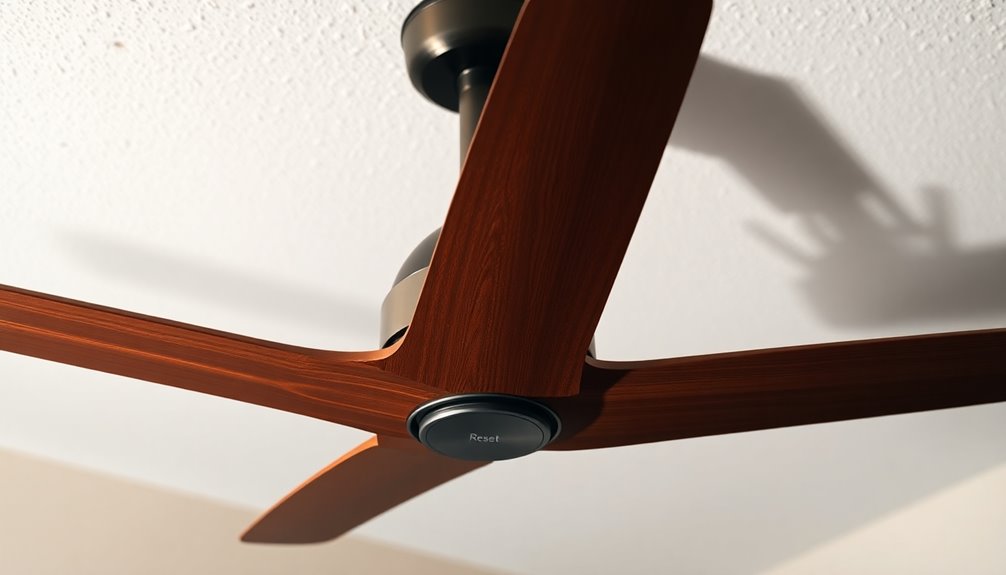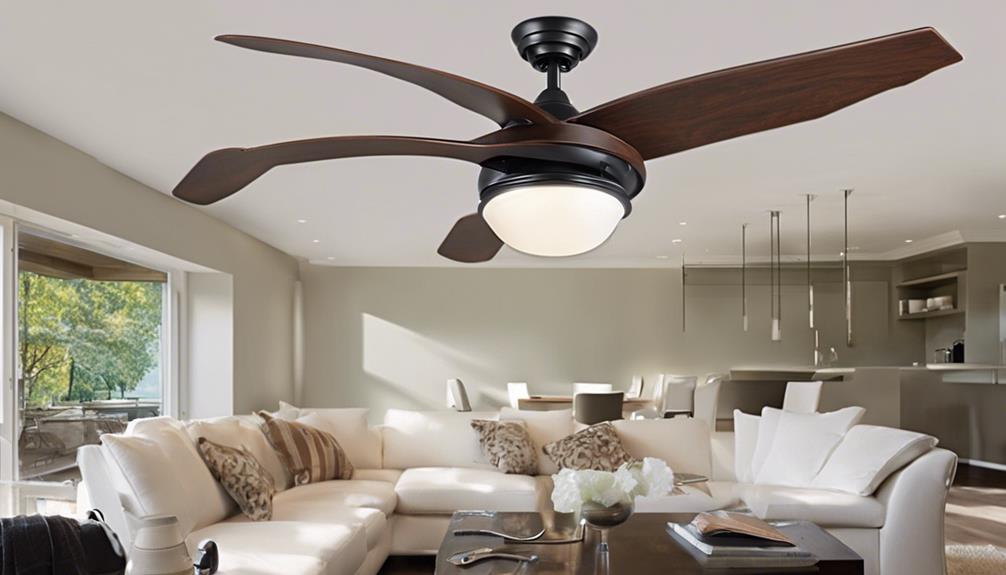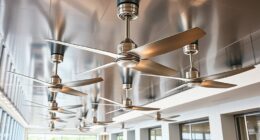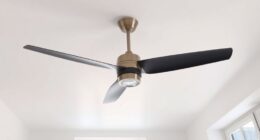Ceiling fans don't use a lot of energy compared to other appliances. Typically, they consume between 50 to 80 watts per hour, averaging around 70 watts on high. In contrast, air conditioners can draw up to 3,500 watts, making fans a much cheaper option. Running a ceiling fan for six hours daily costs you about $18.25 a year, which is less than a few cents a day. Plus, smart fans can optimize performance for even better efficiency. If you want to maximize your comfort and savings, you'll find more helpful tips and insights.
Key Takeaways
- Ceiling fans consume between 50 to 80 watts per hour, making them significantly more energy-efficient than air conditioners, which can use up to 3,500 watts.
- Running a ceiling fan for 6 hours daily costs approximately $18.25 annually, translating to about 5 cents per day.
- Energy Star-rated ceiling fans can be up to 60% more efficient than non-rated models, further reducing energy consumption.
- Proper maintenance and regular cleaning can ensure optimal performance and lower electricity use of ceiling fans.
- Smart ceiling fans utilize machine learning to optimize energy usage, leading to additional savings on electricity bills.
Ceiling Fan Electricity Consumption

Ceiling fans are a popular choice for keeping your home cool without breaking the bank. When you consider ceiling fan electricity consumption, you'll find that running a standard ceiling fan typically uses between 50 to 80 watts per hour, which is considerably less than air conditioners that can draw up to 3,500 watts. This makes ceiling fans a smart option for reducing energy costs.
If you run a standard ceiling fan for about 6 hours a day, you're only looking at an annual electricity usage cost of around $18.25, or just about 5 cents per day.
If you're keen on energy efficiency, consider investing in Energy Star-rated ceiling fans, which can be up to 60% more efficient than non-rated models.
Keep in mind that factors like fan size, speed settings, and additional features like integrated lighting can affect your ceiling fan electricity consumption.
Cost Analysis of Ceiling Fans

When evaluating the cost of cooling your home, ceiling fans emerge as a budget-friendly alternative to air conditioning. A standard ceiling fan uses between 50 to 80 watts per hour without lights, translating to about 5 cents per day for 6 hours of operation. Annually, this amounts to roughly $18.25, making ceiling fans a cost-effective solution compared to other cooling devices. Additionally, incorporating energy-efficient designs in your home can further amplify the savings from using ceiling fans. Many homeowners also find that using ceiling fans alongside an energy-efficient heat pump enhances overall comfort and reduces energy costs.
In contrast, running an air conditioner for the same duration can rack up energy costs exceeding $1.20. This stark difference highlights the energy efficiency of ceiling fans. Additionally, utilizing energy-efficient heat pumps can further enhance overall cooling effectiveness and comfort.
Even when lights are included, ceiling fans only reach 175 to 200 watts, which is still considerably lower than most air conditioning units.
However, it's essential to take local electricity rates into account for an accurate cost analysis. For example, the average rate in July 2023 was around $0.169 per kWh.
With a typical ceiling fan costing about $20 per year to operate, you can see how switching to ceiling fans can drastically reduce your cooling expenses. Additionally, using ceiling fans in conjunction with heat pumps can further enhance energy efficiency by minimizing the workload on your air conditioning system.
Energy Efficiency Tips

To make the most of your ceiling fans, start by choosing the right size for your room to guarantee ideal airflow.
You can also save on energy costs by adjusting your thermostat settings while running the fan.
Plus, don't forget that regular maintenance keeps your fan running efficiently and helps reduce energy consumption. Additionally, using ceiling fans in conjunction with best home security systems can help maintain a comfortable environment while ensuring your home is protected.
Optimize Fan Size
Choosing the right fan size is essential for maximizing energy efficiency in your home. A well-sized ceiling fan can considerably reduce the energy you consume while keeping your space comfortable.
For rooms up to 225 square feet, a 44-inch fan is ideal, while a 52-inch fan works best in spaces up to 400 square feet. Selecting a fan that matches your room size prevents unnecessary energy expenditure, as larger fans typically consume more power.
When you're in the market for a ceiling fan, consider Energy Star-rated models. These fans are 60% more efficient than non-rated options, making them a smart choice for anyone looking to save on energy bills. Additionally, modern fans can raise the thermostat temperature by 4°F, allowing you to use your air conditioning less frequently.
Don't forget about regular maintenance. Cleaning your fan can enhance airflow efficiency, ensuring it operates at peak performance while minimizing energy consumption.
Adjust Thermostat Settings
Adjusting your thermostat settings can markedly enhance your energy efficiency when using ceiling fans. By raising your thermostat by 4°F while letting your ceiling fans do their job, you can greatly reduce air conditioning costs. Fans help circulate cool air, allowing you to feel comfortable without lowering the temperature. This strategy can save you about 15% on cooling costs, making it a smart choice for energy savings.
When you set your thermostat higher, you rely on the breeze effect from the fans, which can make you feel cooler. This combination not only improves your comfort but also leads to energy savings of up to 11% annually, depending on your usage patterns and local electricity rates.
By regularly adjusting your thermostat settings in conjunction with ceiling fan operation, you optimize energy consumption and create a more sustainable and cost-effective cooling strategy.
Incorporating these simple adjustments helps you make the most of your ceiling fans while minimizing the demand on your air conditioning system, ultimately reducing electricity costs and your environmental footprint.
Regular Maintenance Practices
Maintaining your ceiling fans is essential for maximizing their energy efficiency and prolonging their lifespan. Regular maintenance not only enhances air circulation but also helps reduce energy consumption. Here are some key practices to keep your fans functioning effectively:
| Task | Frequency | Benefits |
|---|---|---|
| Clean blades and housing | Monthly | Guarantees ideal airflow and efficiency |
| Check screws and connections | Every 3 months | Prevents wobbling and increases efficiency |
| Adjust blade spacing | Annually | Maximizes air circulation and reduces load on the motor |
| Turn off when not in use | As needed | Considerably lowers electricity costs |
If you're using Energy Star-rated ceiling fans, remember they're up to 60% more efficient than non-rated models, providing better cooling performance while cutting down energy consumption. By incorporating these regular maintenance practices, you can guarantee your ceiling fans operate at peak performance, ultimately reducing energy costs and enhancing comfort in your home.
Room Size and Fan Suitability

Choosing the right ceiling fan size for your room is essential for ideal cooling efficiency.
A 44-inch fan works best in spaces up to 225 square feet, while a 52-inch fan suits larger areas, like living rooms.
Picking the appropriate size not only enhances comfort but also helps you save on energy costs.
Optimal Fan Size
Finding the right ceiling fan size for your room is vital for achieving ideal airflow and energy efficiency. If you have a room up to 225 square feet, a 44-inch ceiling fan is optimal. This size guarantees effective air circulation without excessive energy consumption.
For larger spaces, specifically those up to 400 square feet, a 52-inch fan is recommended. It maximizes airflow while maintaining optimal energy usage.
Choosing the appropriate fan size based on your room dimensions helps prevent unnecessary energy consumption linked to oversized fans in smaller areas. Larger fans can consume more power, so it's important to balance fan size with room size to enhance energy efficiency.
When you use the right size ceiling fan, you'll enhance performance considerably, allowing for effective cooling while keeping energy costs lower than those associated with larger or improperly sized fan models.
Room Cooling Efficiency
When it comes to cooling your room effectively, the size of your ceiling fan plays a crucial role. Choosing the right fan size not only enhances cooling efficiency but also optimizes energy usage. A fan that's too large can create excessive airflow in a small room, leading to discomfort and unnecessary energy consumption.
Here's a quick reference table for fan sizes and their suitability:
| Fan Size | Room Size Capacity |
|---|---|
| 44 inches | Up to 225 square feet |
| 52 inches | Up to 400 square feet |
Using a 52-inch fan, for instance, can consume around 90 watts at high speed, while a smaller 44-inch fan might only use 55 watts. This significant difference in energy usage underscores the importance of selecting the appropriate fan size.
Benefits of Using Ceiling Fans

Ceiling fans are a smart investment for any home, offering a cost-effective way to stay cool. Operating a ceiling fan costs about 5 cents per day for six hours, while air conditioning can run up to $1.20 for the same duration. By using ceiling fans, you can greatly reduce your electricity consumption and enjoy substantial energy savings. Furthermore, they utilize energy-efficient technology that contributes to lowering your overall energy usage. Additionally, implementing mindful practices can further enhance the benefits of energy savings by promoting efficient usage of appliances. Regular maintenance of ceiling fans can also ensure their optimal performance and longevity, leading to even greater energy efficiency. Studies have shown that proper mammography guidelines can lead to early detection and improved outcomes, similar to how efficient ceiling fans can enhance comfort and reduce costs.
These fans enhance indoor comfort by effectively circulating air, creating a wind chill effect that allows you to raise your thermostat settings without sacrificing comfort. This means you can keep your home cooler while relying less on air conditioning, promoting energy efficiency and sustainability.
Choosing Energy Star-rated ceiling fans can further boost your energy savings, as these models are up to 60% more efficient than non-rated versions. Not only do you save on energy bills, but you also contribute to a greener environment. Additionally, maintaining good indoor air quality can further enhance the comfort provided by ceiling fans.
Plus, ceiling fans come in various styles and designs, allowing you to improve your home décor while enjoying their functional benefits.
With all these advantages, it's clear that ceiling fans are a practical choice for maintaining comfort and reducing energy costs in your home.
Comparing Ceiling Fans to Other Appliances

Comparing ceiling fans to other appliances reveals their impressive energy efficiency and cost-effectiveness. When you look at power consumption, ceiling fans typically use between 50 to 80 watts per hour, a stark contrast to air conditioners that can soar up to 3,500 watts. This means that running a standard ceiling fan for 8 hours a day costs you around $18.77 annually, while a window air conditioner might hit you for $81.50 or more in the same period.
Even when stacked against other cooling devices like tower fans and box fans, ceiling fans come out on top. Tower fans average around 100 watts, while box fans can fluctuate between 60 to 110 watts, showcasing the ceiling fan's efficiency. Moreover, using ceiling fans in conjunction with air conditioning can improve energy efficiency by allowing the thermostat to be set at a higher temperature without sacrificing comfort.
If you opt for energy-efficient models, especially those with Energy Star ratings, you could see up to a 60% reduction in energy consumption compared to non-rated fans. For instance, the high-efficiency Aeratron fan operates at just 16.2 watts, costing you around $8 per year. This highlights the remarkable cost-effectiveness of ceiling fans over other options. Additionally, the incorporation of machine learning technology in smart ceiling fans can further optimize their performance and energy usage based on user habits.
Seasonal Fan Direction Usage

Adjusting your ceiling fan's direction seasonally can greatly enhance your comfort and energy savings.
In the summer, you want your fan to rotate counterclockwise. This creates a cooling breeze, pushing air downwards and making the room feel cooler without actually lowering the temperature.
In the winter, switch it to clockwise. This helps circulate warm air that rises to the ceiling, distributing it evenly throughout the room.
To maximize your energy efficiency, consider these key points:
- Temperature Control: By adjusting your fan direction, you can raise your thermostat settings by up to 4°F without sacrificing comfort.
- Ease of Use: Many ceiling fans come with a directional switch or remote control, making seasonal usage a breeze.
- Enhanced Comfort: Properly managing your fan's direction guarantees a consistent flow of air, whether you need cooling or warmth.
Balancing Your Ceiling Fan

To enjoy the full benefits of your ceiling fan, confirming it's properly balanced is key. A well-balanced fan not only enhances its performance but also reduces energy usage by preventing unnecessary strain on the motor. During installation, make sure all screws and mounting hardware are tightened; this will help prevent wobbling.
Regular cleaning of your fan blades is essential. Dust buildup can lead to imbalance, so make it a habit to wipe them down frequently. Additionally, measure the distance between the fan blades and the ceiling. If you notice uneven heights, adjustments may be necessary to maintain balance.
If your ceiling fan is still wobbling after cleaning and adjustments, consider using a ceiling fan balance kit. This kit adds weights to the blades that are out of alignment, stabilizing the fan's motion.
However, if the wobbling persists, it's best to consult a professional electrician. They can inspect the installation and confirm everything is correctly aligned.
Smart and Whole-House Fans

Embracing modern technology can greatly enhance your home's cooling efficiency with smart and whole-house fans. These advanced cooling devices not only improve ventilation but also enhance energy consumption. Here's how they stand out:
- Smart Fans: Designed to connect with smart home systems, smart fans allow you to control them via phone apps, making automated adjustments based on temperature and occupancy. They may have a higher upfront cost, but they save you money in the long run by enhancing energy efficiency. Additionally, incorporating heat pump technology can further optimize energy use in your home.
- Whole-House Fans: Typically consuming between 120 to 600 watts, whole-house fans effectively cool your entire home and ventilate your attic. However, they require professional installation and proper ventilation to function effectively.
- Energy Efficiency: Both smart and whole-house fans improve energy efficiency, but smart fans excel in real-time adjustments, reducing energy consumption while maximizing comfort. Additionally, using best air flow ceiling fans can further enhance cooling effectiveness by providing optimal air circulation.
However, keep in mind that whole-house fans can be noisy and may draw in harmful combustion materials if not properly ventilated.
Using tight vent covers in winter is essential. By choosing the right fans, you can greatly improve your home's cooling strategy.
Frequently Asked Questions
Do Ceiling Fans Raise Electric Bill?
Ceiling fans don't greatly raise your electric bill.
When you use one for about six hours daily, it generally costs you only around 5 cents a day, or about $18.25 annually. This is a fraction of what air conditioning costs.
How Much Does It Cost to Run a Ceiling Fan 24 Hours a Day?
Imagine a warm summer day, and you decide to keep your ceiling fan running for 24 hours.
It'll cost you about $0.30 for a standard fan, or around $0.40 for a larger one. If you've got a fan with lights, it might jump to around $0.84.
Compared to running an air conditioner, you'll find ceiling fans are a much friendlier option for your wallet, saving you plenty over the month.
Is It OK to Leave Ceiling Fans on All the Time?
It's not a good idea to leave ceiling fans on all the time. They don't cool the room but create a wind chill effect, making them ineffective in unoccupied spaces.
If you forget to turn them off, you'll end up wasting energy and money. Instead, turn them off when you leave the room, and consider using them alongside air conditioning to maximize comfort and efficiency without unnecessary costs.
Are Ceiling Fans Expensive to Run?
Ceiling fans aren't expensive to run at all.
You'll find that they typically cost around $20 a year when used daily, which is much less than air conditioners that can hit around $81.50 annually.
If you choose an energy-efficient model, you could save even more on your electricity bill.
Conclusion
To sum up, ceiling fans are a breeze when it comes to energy efficiency. They use relatively little electricity, making them a cost-effective choice for keeping your home comfortable. By following a few energy-saving tips, you can enjoy the benefits without breaking the bank. So, whether you're chilling in summer or cozying up in winter, these fans are like a trusty companion, helping you stay comfortable while keeping your energy bills in check.

